

FLIPPED" Classroom Is All About The Relationships - Edwords Blog - BAM! Radio Network. Most educators who consider flipping develop angst beginning with the fear of making videos.

The concerns typically center on the time necessary to make the videos, the technological skills to produce the videos or the where with all to put voice and/or face on public display. And of course there is the option to use the million or so videos that are already available through, YouTube, Vimeo, Teacher Tube, etc… But I shout from the highest blog post, IT IS NOT ABOUT THE VIDEO!!! While videos do play a roll in most “Flipped” classrooms, the videos are simply a tool that can be employed for delivery of content. Articles, documentaries, textbooks, websites are also valuable tools to disseminate content. Reflections of a CoETaIL Journey. Original photo courtesy of Agribusiness Teaching Center via Wikipedia I have never formally tried to flip my classroom, and before this week’s research I wasn’t clear about my beliefs around reverse instruction or a flipped classroom.
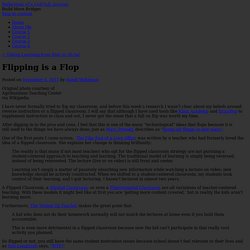
I will say that although I have used tools like Khan Academy and BrainPop to supplement instruction in class and out, I never got the sense that a full on flip was worth my time. After digging in to the pros and cons, I feel that this is one of the many “technological” ideas that flops because it is still used to the things we have always done; just as Marc Prensky describes as “doing old things in new ways”. 5 Reasons Why the Flipped Classroom Works in Higher Education. Education research expert David Miller reveals 5 benefits flipped classrooms provide higher education.
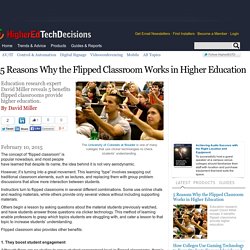
By David Miller February 10, 2015 The concept of “flipped classroom” is popular nowadays, and most people have learned that despite its name, the idea behind it is not very aerodynamic. However, it’s turning into a great movement. This learning “type” involves swapping out traditional classroom elements, such as lectures, and replacing them with group problem discussions that allow more interaction between students. Instructors turn to flipped classrooms in several different combinations.
Others begin a lesson by asking questions about the material students previously watched, and have students answer those questions via clicker technology. Key Questions You Should Ask Before You Flip Your Class. I am preparing to do a workshop with Icelandic Educators this week and I was asked to give them a list of questions to consider as they begin to flip their classes.

As I wrote these I realized that many people could benefit from these questions. It is no doubt an incomplete list. If you have more questions that I should include, please comment and I will add them. Overall Questions What is the best use of your face-to-face class time? Technical Questions about Video Creation: What software will you use to make your videos? The flipped classroom: What to do and not to do. The original concept of flipped classroom found teachers turning their lectures into online videos for viewing outside of class.
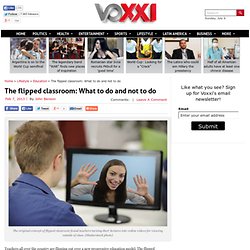
(Shutterstock photo) Teachers all over the country are flipping out over a new progressive education model: The flipped classroom. In a nutshell, the idea of the flipped classroom is based around the question: What’s the best use of class time? The original concept found teachers turning their lectures into online videos for viewing outside of class, while classroom time was dedicated to homework. The reasoning was students traditionally do homework outside of the class but if they have trouble with it they may either not do it or even copy off a classmate. “Chemistry teachers like it because they love to do labs with their students,” Jerry Overmyer, a mathematics and science outreach coordinator at the Univ. of Northern Colorado’s MAST Institute, told VOXXI.
Five Best Practices for the Flipped Classroom. Ok, I'll be honest.

Mark Frydenberg: The Flipped Classroom: It's Got to Be Done Right. As screen-savvy, digital-native Millenials reach college, a dynamic new teaching method is rising across America: the flipped classroom. The premise of a flipped classroom is simple: Instead of lecturing in class and giving homework at home, flip it: give the lectures at home, and do the homework in class. Lectures have been recorded for years, of course. But in 2007, high school teachers Jonathan Bergmann and Aaron Sams pioneered a new movement when they recorded their PowerPoint presentations for students who missed class to watch on their portable music players. 6 Expert Tips for Flipping the Classroom. Tech-Enabled Learning | Feature 6 Expert Tips for Flipping the Classroom Three leaders in flipped classroom instruction share their best practices for creating a classroom experience guaranteed to inspire lifelong learning.
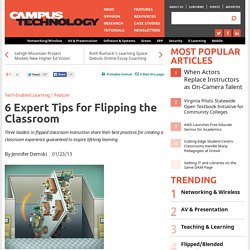
By Jennifer Demski01/23/13 "If you were to step into one of my classrooms, you'd think I was teaching a kindergarten class, not a physics class," laughs Harvard University (MA) professor Eric Mazur. "Not because the students are children, but because of the chaos and how oblivious the students are to my presence. " Such pandemonium is a good thing, insists Mazur, an early adopter of the flipped classroom model that has become all the rage at colleges and universities across the country. In a flipped classroom, professors assign pre-class homework consisting of brief, recorded lectures and presentations, digital readings with collaborative annotation capabilities, and discussion board participation. 2) Be up front with your expectations.
The Flipped Classroom: Pro and Con. In 2012, I attended the ISTE conference in San Diego, CA.
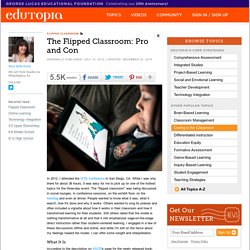
While I was only there for about 36 hours, it was easy for me to pick up on one of the hottest topics for the three-day event. The "flipped classroom" was being discussed in social lounges, in conference sessions, on the exhibit floor, on the hashtag and even at dinner. People wanted to know what it was, what it wasn't, how it's done and why it works.
Others wanted to sing its praises and often included a vignette about how it works in their classroom and how it transformed learning for their students. Still others railed that the model is nothing transformative at all and that it still emphasizes sage-on-the-stage direct instruction rather than student-centered learning. Pros and Cons of The Flipped Classroom. The Flipped Class as a Way TO the Answers. One common criticism of the the Flipped Class is that it really isn’t that big of a change.
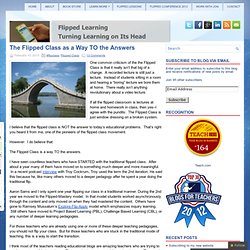
A recorded lecture is still just a lecture. Instead of students sitting in a room and hearing a “boring” lecture we bore them at home. There really isn’t anything revolutionary about a video lecture.